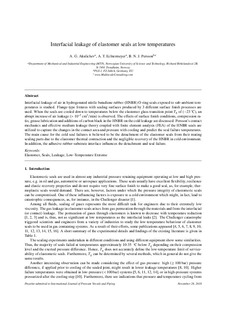| dc.contributor.author | Akulichev, Anton | |
| dc.contributor.author | Echtermeyer, Andreas | |
| dc.contributor.author | Persson, B. N. J | |
| dc.date.accessioned | 2019-02-26T15:01:16Z | |
| dc.date.available | 2019-02-26T15:01:16Z | |
| dc.date.created | 2018-01-18T20:48:00Z | |
| dc.date.issued | 2018 | |
| dc.identifier.citation | International Journal of Pressure Vessels and Piping. 2018, 160 14-23. | nb_NO |
| dc.identifier.issn | 0308-0161 | |
| dc.identifier.uri | http://hdl.handle.net/11250/2587622 | |
| dc.description.abstract | Interfacial leakage of air in hydrogenated nitrile butadiene rubber (HNBR) O-ring seals exposed to sub-ambient temperatures is studied. Flange-type fixtures with sealing surfaces produced by 3 different surface finish processes are used. When the seals are cooled down to temperatures below the elastomer glass transition point Tg of (−23 ◦C), an abrupt increase of air leakage (> 10−2 cm3 /min) is observed. The effects of surface finish conditions, compression ratio, grease lubrication and additions of carbon black in the HNBR on the cold leakage are discussed. Persson’s contact mechanics and effective medium leakage theory coupled with finite element analysis (FEA) of the HNBR seals are utilized to capture the changes in the contact area and pressure with cooling and predict the seal failure temperatures. The main cause for the cold seal failures is believed to be the detachment of the elastomer seals from their mating sealing parts due to the elastomer thermal contraction and the negligible recovery of the HNBR in cold environment. In addition, the adhesive rubber-substrate interface influences the detachment and seal failure. | nb_NO |
| dc.language.iso | eng | nb_NO |
| dc.publisher | Elsevier | nb_NO |
| dc.rights | Attribution-NonCommercial-NoDerivatives 4.0 Internasjonal | * |
| dc.rights.uri | http://creativecommons.org/licenses/by-nc-nd/4.0/deed.no | * |
| dc.title | Interfacial leakage of elastomer seals at low temperatures | nb_NO |
| dc.type | Journal article | nb_NO |
| dc.type | Peer reviewed | nb_NO |
| dc.description.version | acceptedVersion | nb_NO |
| dc.subject.nsi | VDP::Maskinfag: 570 | nb_NO |
| dc.subject.nsi | VDP::Mechanical engineering: 570 | nb_NO |
| dc.source.pagenumber | 14-23 | nb_NO |
| dc.source.volume | 160 | nb_NO |
| dc.source.journal | International Journal of Pressure Vessels and Piping | nb_NO |
| dc.identifier.doi | 10.1016/j.ijpvp.2017.11.014 | |
| dc.identifier.cristin | 1546851 | |
| dc.relation.project | Norges forskningsråd: 234115 | nb_NO |
| dc.description.localcode | © 2017. This is the authors’ accepted and refereed manuscript to the article. Locked until 212.2019 due to copyright restrictions. This manuscript version is made available under the CC-BY-NC-ND 4.0 license http://creativecommons.org/licenses/by-nc-nd/4.0/ | nb_NO |
| cristin.unitcode | 194,64,92,0 | |
| cristin.unitname | Institutt for maskinteknikk og produksjon | |
| cristin.ispublished | true | |
| cristin.fulltext | postprint | |
| cristin.qualitycode | 1 | |

